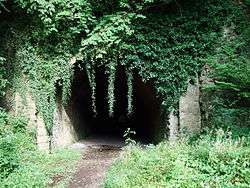Coleford, Monmouth, Usk and Pontypool Railway
|
The 256-yard Usk Tunnel in 2008, now a public footpath. | |
| Locale | Monmouthshire |
|---|---|
| Dates of operation | 1856–1955 (section to ROF Glascoed remained open until 1993) |
| Track gauge | 4 ft 8 1⁄2 in (1,435 mm) standard gauge |
| Length | 16 miles (26 km) |
Coleford, Monmouth, Usk & Pontypool Railway | |||||||||||||||||||||||||||||||||||||||||||||||||||||||||||||||||||||||||||||||||||||||||||||||||||||||||||||||||||||||||||||||||||||||||||||||||||||||||||||||||||||||||||||||||
|---|---|---|---|---|---|---|---|---|---|---|---|---|---|---|---|---|---|---|---|---|---|---|---|---|---|---|---|---|---|---|---|---|---|---|---|---|---|---|---|---|---|---|---|---|---|---|---|---|---|---|---|---|---|---|---|---|---|---|---|---|---|---|---|---|---|---|---|---|---|---|---|---|---|---|---|---|---|---|---|---|---|---|---|---|---|---|---|---|---|---|---|---|---|---|---|---|---|---|---|---|---|---|---|---|---|---|---|---|---|---|---|---|---|---|---|---|---|---|---|---|---|---|---|---|---|---|---|---|---|---|---|---|---|---|---|---|---|---|---|---|---|---|---|---|---|---|---|---|---|---|---|---|---|---|---|---|---|---|---|---|---|---|---|---|---|---|---|---|---|---|---|---|---|---|---|---|---|
Legend
| |||||||||||||||||||||||||||||||||||||||||||||||||||||||||||||||||||||||||||||||||||||||||||||||||||||||||||||||||||||||||||||||||||||||||||||||||||||||||||||||||||||||||||||||||
The Coleford, Monmouth, Usk & Pontypool Railway (abbreviated CMU&PR) was a 4 ft 8 1⁄2 in (1,435 mm) standard gauge railway of 16 miles (26 km) which ran between Monmouth to Pontypool in Monmouthshire, Wales. It was completed in 1857, passenger services were withdrawn in 1955.
History
The line was constructed opened 1856 and 1857 with the principal aim of carrying iron ore from the Forest of Dean to furnaces near Nantyglo. It was authorised under an Act of Parliament dated 20 August 1853, to operate from a junction with the Newport, Abergavenny & Hereford Railway, near Pontypool, to Coleford, Gloucestershire, with a branch to serve the gas works at Monmouth. Diverging at Little Mill Junction, two miles north west of Pontypool Road railway station, the line ran to Monmouth Troy railway station. The Monmouth Viaduct was built over the River Wye in an attempt to reach Coleford in the Forest of Dean, but following the purchase of the line by GWR the scheme was abandoned.[1] The link to Coleford was later completed by the GWR and opened as the Coleford Railway in 1883.[2]
The four miles from Little Mill Junction to Usk were opened on 2 June 1856, and the 12 miles onwards to Monmouth Troy opened on 12 October 1857. At first the company worked its line with engines hired from the Newport, Abergavenny and Hereford Railway, before coming under the control of the GWR.[3]
From 1940 ROF Glascoed which produced munitions for the armed services was served by the line with a branch and two small halts.[4] When the line officially closed the factory continued to be served by rail along the eastern section of the line until 1993. The overgrown track from Little Mill Junction to what is now BAE Systems factory remains in situ but is completely impassable.[1]
The line was closed on 30 May 1955 due to a train drivers strike and was never reopened. Its closure was originally planned for June 1955, but because of the strike the last service was run 28 May when the national strike began.[3] A Stephenson Locomotive Society special ran along the line exactly 100 years from opening on 12 October 1957.[2][3]
Stations
The Railway had stations at Little Mill Junction, Usk, Llandenny, Raglan, Dingestow and Monmouth Troy. Monmouth Troy Station was the terminus of the Wye Valley Railway from 1876–1964, the Ross and Monmouth Railway from 1874–1964 and the Coleford Railway from 1883-1917.[5][6] Usk and Monmouth Troy were the only stations on the line with two platforms.[7] Halts were added at Glascoed (1927), Elms Bridge, (1933) and Cefntilla (1954). Raglan Station, known as Raglan Road, was closed in 1931 and was moved to a previously unofficial stopping place called Raglan Footpath. The original station was then re-opened as a halt on 24 July 1931.[2]
References
- 1 2 V. Mitchell and K. Smith, Branch Line to Monmouth, 2008, ISBN 978-1-906008-20-8
- 1 2 3 B. M. Handley and R. Dingwall, The Wye Valley Railway and the Coleford Branch, 1982, ISBN 0-85361-530-6
- 1 2 3 Stanley C Jenkins, The Ross, Monmouth and Pontypool Road Line, revised second edition 2009, ISBN 978-0-85361-692-4
- ↑ Nicholson, Gawain. "The Coleford, Monmouth, Usk and Pontypool Railway". Retrieved 12 July 2013.
- ↑ Mike Hall, Lost Railways of South Wales, 2009, ISBN 978-1-84674-172-2
- ↑ Stan Yorke, Lost Railways of Gloucestershire, 2009, ISBN 978-1-84674-163-0
- ↑ "Usk station, Monmouthshire". urban75. Retrieved 12 July 2013.

